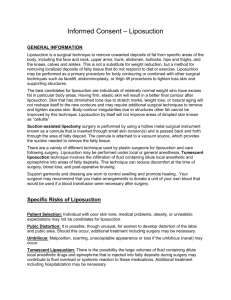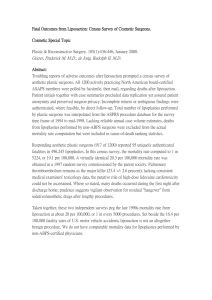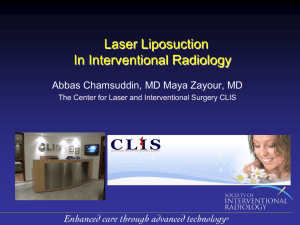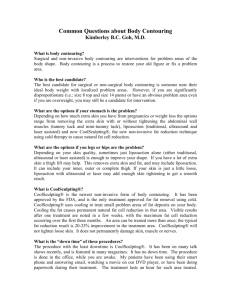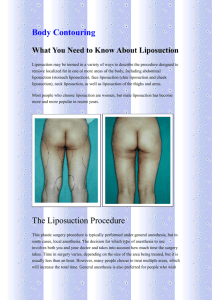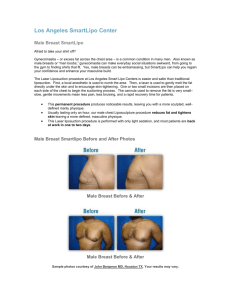Liposuction
advertisement
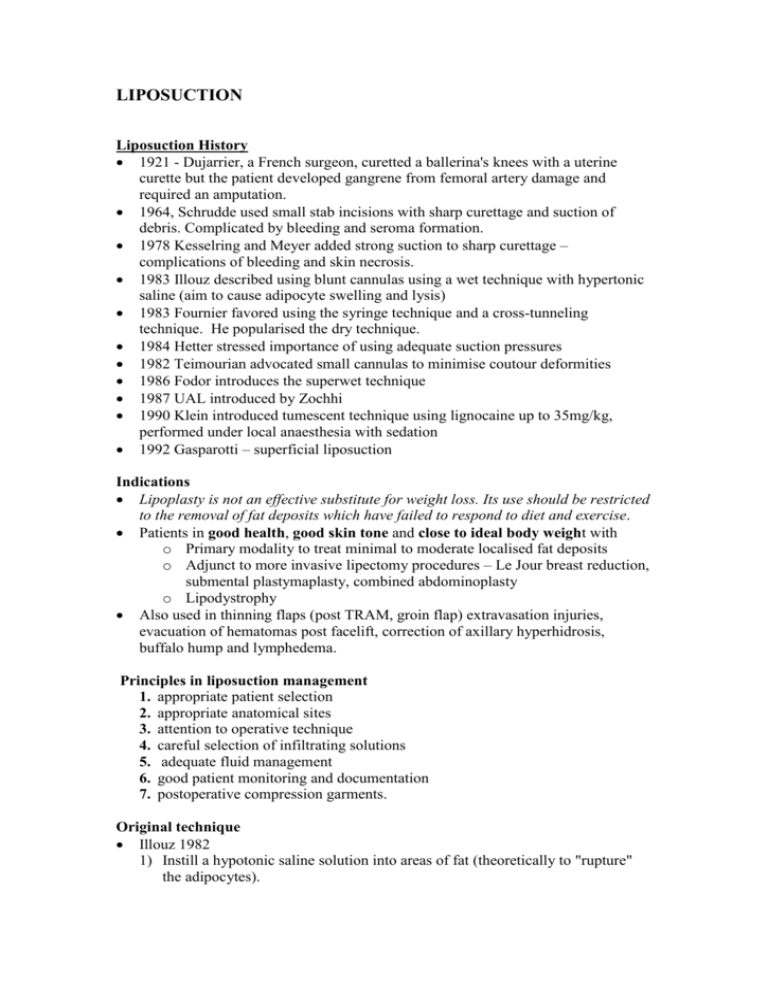
LIPOSUCTION Liposuction History 1921 - Dujarrier, a French surgeon, curetted a ballerina's knees with a uterine curette but the patient developed gangrene from femoral artery damage and required an amputation. 1964, Schrudde used small stab incisions with sharp curettage and suction of debris. Complicated by bleeding and seroma formation. 1978 Kesselring and Meyer added strong suction to sharp curettage – complications of bleeding and skin necrosis. 1983 Illouz described using blunt cannulas using a wet technique with hypertonic saline (aim to cause adipocyte swelling and lysis) 1983 Fournier favored using the syringe technique and a cross-tunneling technique. He popularised the dry technique. 1984 Hetter stressed importance of using adequate suction pressures 1982 Teimourian advocated small cannulas to minimise coutour deformities 1986 Fodor introduces the superwet technique 1987 UAL introduced by Zochhi 1990 Klein introduced tumescent technique using lignocaine up to 35mg/kg, performed under local anaesthesia with sedation 1992 Gasparotti – superficial liposuction Indications Lipoplasty is not an effective substitute for weight loss. Its use should be restricted to the removal of fat deposits which have failed to respond to diet and exercise. Patients in good health, good skin tone and close to ideal body weight with o Primary modality to treat minimal to moderate localised fat deposits o Adjunct to more invasive lipectomy procedures – Le Jour breast reduction, submental plastymaplasty, combined abdominoplasty o Lipodystrophy Also used in thinning flaps (post TRAM, groin flap) extravasation injuries, evacuation of hematomas post facelift, correction of axillary hyperhidrosis, buffalo hump and lymphedema. Principles in liposuction management 1. appropriate patient selection 2. appropriate anatomical sites 3. attention to operative technique 4. careful selection of infiltrating solutions 5. adequate fluid management 6. good patient monitoring and documentation 7. postoperative compression garments. Original technique Illouz 1982 1) Instill a hypotonic saline solution into areas of fat (theoretically to "rupture" the adipocytes). 2) Insert blunt-tipped, hollow metal cannulas (of 5-, 8-, and 10-mm internal diameters with a lateral side opening) into these fatty deposits. 3) Attach the cannulas via hose or tube to a high-power suction machine. 4) Move these cannulas in and out of the fat in a fan-shaped pattern. Advances 1) smaller cannulas with blunt tips and more holes a. better contouring b. able to get to smaller anatomic regions c. less traumatic 2) wetting solutions Wetting solutions Typical mixture: 1. 1000ml Ringers warmed to 32 2. 1ml of 1:1000 Adrenaline 3. 25ml of 2% lignocaine(20mg/ml) Risks of bleeding depends on: =1:1,000,000 =0.05% =500mg 1. 2. 3. 4. 5. type of wetting solution site of liposuction number of passes size of cannula plane of liposuction – deep bleeds less Estimation of blood loss with dry technique, 1% drop in haematocrit for every 88ml of aspirate with wet technique, 1% drop in haematocrit for every 150ml of aspirate(Hetter’s predictive rule of 150) with superwet technique, 1% drop in haematocrit for every 250ml of aspirate Using the 150 rule, liposuction under 1500mls should not drop the heamatocrit >10%, so unlikely to need blood transfusions Due to the amount of blood loss associated with the dry technique, its use is not recommended except in limited applications with a volume of 100 cc of total aspirate or less . The dry technique should never be used in conjunction with ultrasound-assisted liposuction. Infiltration solution (tumescent) Absorption rate in heavily infiltrated subcutaneous tissue is decreased due to 1) infusion into a relatively avascular space 2) local vasoconstriction 3) absorption of lignocaine by adipocytes 4) very dilute concentrations (lidocaine ≤0.1% and epinephrine ≤1:1,000,000). Adrenaline 1) 0.07mg/kg but up to 10mg reported to be safe (PRS 1996), usual 4-5mg. 2) Peak serum levels occur at 3hours (up to 4x normal) 3) Return to normal at 12 hours 4) Symptomatic reactions:anxiety, restlessness, tremor, weakness, headache, pallor, palpitations, nausea, and vomiting. 5) Catecholamine overdose presents clinically with hypertension, chest pain, diaphoresis, tachycardia, paraesthesia of extremities, and cardiac arrhythmias. 6) Adverse reactions may progress to hypotension, metabolic acidosis, pulmonary edema, asystole, and death 7) use should be avoided in patients who present with pheochromocytoma, hyperthyroidism, severe hypertension, cardiac disease, or peripheral vascular disease. Lignocaine 1) Minimal concentration of 0.04% required for anaesthesia 2) Evidence that using lignocaine reduces post-op analgesia requirements for 1824 hours 3) Peak serum levels occur at 12 hours 4) Max dose 35mg/kg (Klein), 55mg/kg (Ostad) for tumescent technique otherwise usual limit is 7mg/kg (with adrenaline) 5) Side effects are: a. CNS – excitatory then depressant: light-headedness, nervousness, apprehension, euphoria, confusion, dizziness, drowsiness, tinnitus, blurred or double vision, vomiting, sensations of heat, cold or numbness, twitching, tremors, convulsions, unconsciousness, respiratory depression and arrest. b. CVS - usually depressant and are characterized by bradycardia, hypotension, and cardiovascular collapse, which may lead to cardiac arrest. Is lignocaine necessary? - controversial Perry PRS 1999 - study failed to show a significant difference in postoperative pain and concluded that lignocaine to be unnecessary in liposuction performed under general or epidural anesthesia. Many plastic surgeons prefer to not have lignocaine in large volume liposuction and go with GA. Reply by Jeff Klein:He feels GA is more dangerous 1. the dose-dependent impairment of protective laryngeal reflexes and respiratory depression, 2. the temptation to do too much liposuction on a single day 3. multiple unrelated cosmetic surgical procedures on the same day 4. thromboembolism associated with excessive surgical trauma 5. iatrogenic pulmonary edema resulting from unnecessary use of intravenous fluids following tumescent infiltration. When liposuction is done totally by local anesthesia, these risks are virtually eliminated. Because of the limits on total lidocaine dosage, the volume of liposuction is usually less than 3 liters of supranatant fat. Marcaine, the longest-acting anesthetic in its class, is rapidly absorbed, has the slowest elimination in its class, and is not readily reversed. Marcaine toxicity affects the cardiovascular, neurologic, and hematologic systems and may result in cardiac arrhythmias, seizure, and coma with respiratory depression. Not recommended in wetting solutions Large Volume Liposuction With wet technique, Illouz observed the following: If more than 500 ml of fat is re-moved, fluid replacement is required. If more than 1500 ml of fat is re-moved, blood transfusion is required. Those patients having removals of more than 2000 ml often required overnight observation and ongoing fluid replacement. Major problems occur after 2500 to 3000 ml are removed. As a general rule, excisions should not exceed 2000 ml, with 2500 ml being the upper limit. Most commonly, large volume liposuction is defined as >4L of supernatant fat removed or >5L total volume. The increase in adverse events with lipoplasty has been associated almost exclusively with large volumes of preinjectate and aspirated tissue, the risk of complications is unavoidably higher as the volume of fluid exchange increases Large-volume liposuction combined with certain other procedures has resulted in serious complications, and such combinations should be avoided Minimising Risks 1. The surgeon must be properly trained and educated in liposuction techniques and have a thorough understanding of the physiologic changes that occur with regular and large volume liposuction. 2. The anesthesiologist working with the surgeon also must be well trained and have a complete understanding of the physiology associated with infusion and removal of large volumes of fluids. 3. The facility where the procedure is performed must be completely equipped to deal with any problem or complication that may occur during or after the procedure. The facility should be certified and accredited by a nationally recognized surgery accreditation body. 4. The support staff working in the operating room and recovery room should be thoroughly trained and familiar with the procedure, care, and recovery of the patient. 5. The patient must be selected appropriately for the procedure Healthy mentally and physically, ASA<III Not morbidly obese, stable weight Realistic goals Intraop monitoring Keep patient warm – warming blankets, fluids, operating room IDC Calf compression pumps Admit overnight for analgesia and fluid monitoring Compressive garments Fluid Management Estimated that aspirate will contain 30% of the infiltrate – thus 70% will be absorbed into the blood stream. Rohrich intraoperative fluid ratio (PRS Feb 2006) intraoperative fluid ratio was defined as the sum of the super-wet infiltration volume plus the intraoperative intravenous fluid volume divided by the volume of aspiration. He maintains intraoperative fluid ratios near 1.8 for small-volume reductions and 1.2 for large-volume aspirations Despite this urine output was still high (2.9 ml/kg/hour and 2.5 ml/kg/hour for the small- and large-volume groups) Residual fluid theory (G Commons, PRS 2001) Uses the principle of Hypodermoclysis - the injection of large volumes of fluid into the tissues for hydration. The residual volume represents the fluid available for autoresuscitation by hypodermoclysis Residual fluid volume = total fluid volume in - total fluid volume out. Total fluid volume in = total volume of wetting solution used + total volume of intravenous fluid used. The total volume out = total volume of aspirated wetting solution (which is approximately 30 percent of the total aspirated volume in most cases) + urine output. By retaining a residual volume of 120 ml/kg, fluid balance inconsistencies or difficulties can be avoided. Relies heavily on the slow absorption of the wetting solution from the subcutaneous space in the postoperative period. This is facilitated by compression garments and would prevent third spacing and further promote shifting of the fluid into the intravascular space. Complications: Major 1. death : risk is 1:5000 (PRS 1999) a. causes 2. pulmonary oedema a. cardiogenic b. noncardiogenic (increased capillary permeability) – ARDS c. epidural anaesthesia may worsen this by predisposing to vasodilatation and hypotension 3. lignocaine toxicity – worsened by a. hepatic disease (metabolised in liver) b. renal disease c. cardiac disease d. hyperthyroidism – cardiac excitability e. hypovolumia (increased plasma levels) f. drug interactions (SSRI) 4. hypothermia 5. pulmonary thrombosis/DVT 6. fat embolism syndrome 7. penetration injuries a. lung b. cardiac c. bowel 8. bleeding/haemorrhage and unplanned blood transfusions 9. skin burns (UAL), necrosis 10. infection, necrotising faciitis Minor 1. contour irregularities 2. prolonged swelling 3. scars 4. seromas – more common with UAL. Treat with serial aspiration and postoperative compression 5. nerve injuries - sensory changes 6. skin blisters 7. long term skin staining from hemosiderin Equipment Suction-assisted High powered suction usually 1atm of negative pressure End points of SAL 1. Final contour 2. Pinch test Cannulas: Multiple openings facilitate extraction of fat and traumatize the tissue less because repeated movement over a given area is minimized. Power-assisted Can be electrically or gas-driven, small motor drives the 2-4mm tip Advantage in decreasing fatigue Disadvantage: noisy and excessive vibration Internal Ultrasound-assisted Pioneered by Zocchi 1993 ultrasonic generator, which transmits electrical energy to a handpiece containing a piezoelectric crystal that converts the incoming electrical signal into a mechanical vibration at an ultrasonic frequency of 20–30 kHz with a cyclical displacement of around 100 μm. Mechanism of action 1. Cavitation o Sound waves consist of alternating expansion and compression cycles. o The compression phase exerts positive pressure in the medium, while expansion results from the negative pressure phase. o Ultrasound of sufficient intensity can produce microbubbles in a liquid or semiliquid medium during the expansion cycle. Rupture of these bubbles lead to microcavitation – causes emulsification of fat o Microcavitation can be observed at the tip of a UAL cannula, although the energy is rapidly dispersed. o Concern of free radical production and chromosomal damage 2. Thermal effects o passage of heat through fatty tissue is poor, so that loss of heat may be limited – skin at particularly risk but also connective tissue 3. Direct tissue effects Benefits: 1. Easier removal of fat from fibrous areas - gynecomastia, the back, upper abdomen, and posterior hip rolls. 2. more even shaping of overlying skin surfaces 3. less blood loss (probably the same as SAL, PRS 2001) 4. less vascular disruption to flaps 5. improved skin retraction To prevent thermal injury 1. never apply to dry tissue – usually superwet or tumescent 2. cannula must be kept in motion Procedure: 1. Stage I: subcutaneous infiltration to decrease tissue density and blood loss 2. Stage II: UAL to emulsify fat 3. Stage III: evacuation of emulsified fat and final contouring with SAL End points of UAL: 1. Loss of tissue resistance 2. blood tinged aspirate Disadvantages 1. skin burns/necrosis (4%) o entry burn - a skin protector is used at the entry site (longer incision) o tip burn – thermal end-hit – reduce risk by using adequate volume of wetting solution o devascularisation 2. fat necrosis (4%) 3. dysesthesias (6%) - potential for injury to myelin sheaths because of their high lipid content 4. skin staining from hemosiderin 5. high seroma rates – reduced with evacuation of emulsified fat 6. rare risk of air embolus 7. longer operating times 8. potential damage to DNA – through the generation of free radicals Recommendations (ANZ 2001) 1. proper training in use of device – thermal injury and endpoints 2. use as an adjunct to SAL 3. use of submaximal amplitude settings except in very fibrous zones 4. limiting treatment time 5. not recommended for female breast contouring - The concern is that cancer of the breast that has not yet spread locally or remotely could do so. solid probe is thought to be a more efficient fat emulsification device, but its use requires a two-step process in which the fat must be emulsified and then evacuated separately. Devices 1. First-generation (eg, SMEI, Casales), used blunt solid titanium probes 4-6 mm in diameter followed by aspiration with standard cannulas. 2. Second-generation (eg, Lysonix, Mentor) use hollow cannulas for simultaneous aspiration and ultrasound delivery. When the aspirate changes from pale yellow to pink or gray, emulsification is complete. 3. Third generation are solid probes with some changes in probe design ie VASER=grooves in the probe near the tip result in radial dispersion of acoustic energy, yielding more effective emulsification with lower total energy application. These probes are 2.9 mm and 3.7 mm in diameter, so smaller incisions are required. Another has water cooled outer sleeve. External Ultrasound-assisted(XUAL) Requires traditional aspirative liposuction after the application of high-frequency ultrasonic fields delivered through the skin into wetted tissue. Delivers 1 MHz of ultrasound energy in a continuous or pulsed cycle. Maximum power is 30 W or 3 W/cm2. Method: 1. Superwet or tumescent 2. A coupling gel is used to prevent air interference at the skin-transducer interface. 3. XUAL is applied to the treatment areas using circular strokes continuously for 10 minutes to each side. 4. The transducer must be moved continuously to prevent overheating. After the ultrasound application, standard tumescent liposuction is performed. Reported benefits (controversial – recent studies find no benefit) 1. Greater cannular maneuverability 2. Increase in the proportion of supernatant fat observed in the aspirate 3. Decrease in postoperative ecchymosis, swelling, and discomfort. Laser-assisted(LAL) Clinics 1996 with YAG laser in probe concluded that no clear benefit was demonstrated for liposuction. FDA did not approve the technique, and the sponsoring laser company has not pursued the study. Liposuction Techniques four key elements for long-term successful improvement in body contour, and the patient is responsible for the first three 1. exercise 2. a proper diet 3. other positive lifestyle changes 4. successful body contouring. 1. Deep (Traditional) SAL a. Poiseuille’s Law – suction flow determined by canulla diameter and length b. Crisscross tunnelling (honeycombing) 2. Superficial SAL (Gasparotti 1992) a. Traditionally thought to lead to contour irregularities b. This avoided by using thin cannulas with some areas undermined without aspirating c. Benefit is it allows skin retraction not possible with deep liposuction – “controlled scar retraction of the thin cutaneous adipose flap remaining after the treatment, allows for very good results even in very flaccid and aged skin” (Gasparotti) d. Best for i. Younger patients ii. Outer thigh banana deformity iii. Secondary liposuction iv. Cellulite e. Buttocks not amenable to liposuction Lockwood’s recommendations: Remove only fat that is diet and exercise resistant Superficial fat is generally not removed in areas with deep localised fat deposits Specific Areas 1. Face Use smallest cannulas and not to extend above zygomatic arch Irregularities common Injury to MM nerve reported 2. Neck Preplatysma fat great for liposuction One of the few areas where skin takes up to recreate the cervicomandibular angle. May unmask anterior platysma banding in nondecussated platysmas 3. Upper arms Schlesinger 4 cannula technique (3mm cannulas of different length progressively used thru 1 distal port) Gilliland – circumferential, paraaxillary, superficial, tumescent (CAST) liposuction. Circumferential treatment said to enhance skin retraction Rohrich – uses UAL for posterior 1/3 and SAL for anterior 2/3 of arm 4. Thighs Commonly used for saddle-bags (lateral trochanteric regions) Distal to midthigh, superficial and deep fat layers merge into one – liposuction becomes riskier. Avoid zones of adherence, and preserve silhouette in women Liposuction of the Legs and Ankles (PRS May 2004) Lower leg lipodystrophy – mostly affeting young female Below knee liposuction has been controversial Feared complications i. persistent edema Iliouz warned that the postoperative edema in this area was much greater than in any other anatomical zone, lasting up to 6 months ii. persistent pigmentation attributable to the dependent location iii. contour irregularity irregularities are more commonly palpable than visible iv. ulceration v. poor patient satisfaction not as slim as patient expected asymmetries hypesthesia unexpectedly severe postoperative pain Anatomical challenges 1. one layer of fat, with dense fibrous tissue and many lymphatics o largely responsible for easily caused postoperative skin irregularities. o because of this thin subcutaneous fat layer, postoperative hematomas or ecchymosis may result in pigmentation of the skin itself. o In addition, the dependent nature of the lower legs, the fibrous nature of the fat, and possibly the disruption of the dense lymphatics from certain techniques engender a constant tendency toward postoperative edema. 2. fat distribution may only be partially responsible - also the product of bone and muscle configuration. 3. Variable fat characteristics o subcutaneous fat in the medial lower calf is softer and easier to suction than that more laterally o leads to a greater reduction and resultant overall concavity medially if this anatomic factor is not taken into account. 4. Popliteal fossa is a no-go-zone 5. Circumferential except at o confluent between the perimalleolar regions across the pretibial region. This paucity of fat extends superiorly over the anterior tibia. o significant fat is never present over the Achilles tendon distally. Thus liposuction rarely changes the anteroposterior dimension of the lower leg or ankle, which is instead determined by the distance between the anterior tibia and the posterior surface of the Achilles tendon Preoperative assessment Contraindications 1. patients with a history of deep venous thrombosis, phlebitis, hypercoagulability, or any history of a previous thrombotic event 2. circulatory insufficiency. 3. Active phlebitis 4. chronic edema, trophic anomalies, and severe varicosities - Mild varicosities do not preclude liposuction, and these patients are not subject to increased postoperative morbidity. If vein stripping is planned for severe varicosities, this should precede liposuction by 3 months Younger patients with more elastic skin do better Most use pinch test - vary between authors, but pinch tests of 1.5 to 2 cm of fat at the calf and 1 to 1.5 cm at the ankle are felt by many to represent an indication for surgery. perform the pinch test while the patients stand on a stool. Usually, it is performed with the patient standing flatfooted, and then standing on the toes standing on the toes will flex and therefore help to define the edges of the gastrocnemius muscle bellies for marking Mladick proposed the benefits of marking the patient in the sitting position with the legs dangling, claiming that dangling legs are more supple, which makes it easier to differentiate the thickness of the fat bulges from the underlying muscles and tendons Newer literature suggests that good results usually can be expected. Despite prolonged postoperative edema, after 6 months these patients are some of the most grateful. Target areas Ankles Most patients' concerns regard areas of excessive fat distally over the medial and lateral malleoli on either side of the Achilles tendon Lower calf excess fat often blunts the definition of the inferior bellies of the gastrocnemius muscles, especially medially. Such an obscure transition between the gastrocnemius muscles and the more inferior leg contributes to a columnar appearance. Method Mladick – supine Klein – lateral decubitus and than change to other side Some perform this under local anaesthetic, so patient can assist by changing position Chamosa two-stage procedure - first stage, liposuction of only half of the circumference on each leg and ankle was performed under general anesthesia. The second stage was performed at 3 weeks, which involved completion of the procedure under local anesthesia. Others have proposed dry liposuction under tourniquet control, with compression applied before deflation – shown to prevent both bruising and edema from ever developing. Allows better sculpting of contours without wetting solution. Incisions usually bilaterally at knee, midpoint and just above ankle Main difference with other areas is the use of small cannulas most authors currently use cannulas in the range of 2 to 5 mm, often using the smallest for refinements around the ankles. Mladick recognized that the delicate curves of the legs make liposuction with straight cannulas difficult. He uses convexly and concavely curved cannulas. Most leave about 5mm of fat Longitudinal cannula direction is recommended over transverse as this is less likely to cause major lesions of epifascial lymph vessels. If use transverse suctioning (often need to for feathering out), use small 2-3mm cannulas (Mladick PRS 1999) Important to feather between the junctions of defatted and nondefatted portions of the leg with a 4-mm cannula Circumferential liposuction, once feared, is routinely done. Postop sequential compression devices is essential - can markedly shorten the period of swelling and morbidity for patients having lower leg liposuction After finishing the first leg, Mladick tightly wrapped it with a 6-inch Ace wrap to above the knee while the contralateral leg was contoured and likewise bandaged Some use medical grade graduated compression stockings in the range of 35 to 40 mmHg Other add steroids to wetting solution to reduce oedema Rohrich reported the use of external ultrasound two to three times per week for 3 or 4 weeks combined with manual massage in the office to facilitate edema resolution Specific Complications DVT Undercorrection o most frequentcomplain is persistent ankle thickness (10%), partly due to edema and underresection of the ankles perforation of the capsula articularis o more likely with knee flexion o treat the injury with an elastic bandage and antibiotics. Hyperpigmentation Superficial blistering over the Achilles tendon o Rare, often caused by tight compression garment over this area telangiectasia, contour depressions Infection skin slough phlebitis posttraumatic tendonitis Peroneal nerve injuries
